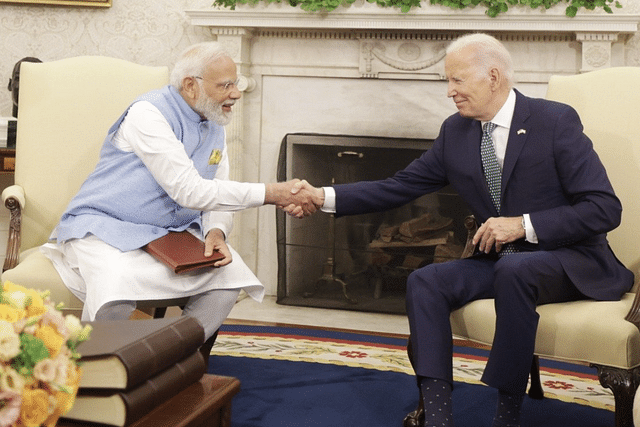World
Why India Must Learn To Suck It Up With Uncle Sam For 10 More Years
R Jagannathan
Mar 28, 2024, 12:01 PM | Updated 12:00 PM IST
Save & read from anywhere!
Bookmark stories for easy access on any device or the Swarajya app.

The unwarranted comments by, first, Germany and then the US on the arrest of Arvind Kejriwal have been called out by many people, including the Ministry of External Affairs.
But the US has chosen to double down and extend this political interference by making comments on the Congress party’s frozen accounts, too.
While India has summoned German and US diplomats to convey its displeasure, clearly this approach is not going to work beyond a point because we are talking about the asymmetry of power here.
At this stage in our development, we need the US more than the US may think it needs us. Hence the best strategy for us is to suck it up as often as possible, and wait till we become a $10 trillion economy, where what we say will begin to matter to all middle powers if not the US.
This is what China did for 30 years. It began talking about its own agenda only in the last decade or so, after it became the world’s No 2 economy and military superpower, and also figured out that US supremacy was in decline.
India also needs to note that when it comes to our economic rise, both Uncle Sam and Papa Xi have the same goals. They do not want India to rise too fast or too much, because it threatens their own global power and hegemony.
Also, they have a vested interest in India having weak governments, which can then be bought off by a high-profile project or two, which again will be beholden to the US. This is what the US thought it was doing by giving Manmohan Singh the India-US nuclear deal.
India’s vulnerabilities stem from two major sources, among others.
One is defence. While we are not over-dependent on the US for hardware, our attempts to make our own aircraft (the Tejas), for example, are dependent on the supply of US engines.
Also, many tech projects depend on US supplies. Going back to dependence on Russia is not a real option, at least till the Ukraine war is over. Till then, the Russian defence industry’s focus will be on building its own hardware, not India’s needs.
The second, and more important vulnerability, is software services. India’s biggest market for software services is North America, and the ability of the US to put a crimp on this revenue source is enormous, even though this will damage their own technological abilities, which are heavily dependent on Indian engineers working for US companies.
With the rise of global capability centres (GCCs) in India, high-quality jobs in India depend a lot on alignment with US corporate interests, which again is dependent on political cues from the US government.
There may be other, smaller, vulnerabilities, but as an economy just shy of $4 trillion, India cannot afford to antagonise the US beyond a point. Hence the need to zip it up despite provocations.
The US will come around when we are really a $10 trillion economy, and they have little room to make a full-time enemy out of us. This means we must not escalate issues beyond a point.
What we can, and must do, is seek a degree of 'atmanirbharta' in supply chains that are linked both to the US and China. They are frenemies, as much against us as for us. China may be a bigger threat, but the US is also a nagging problem.
Second, we have to build our own domestic market for software services, so that overdependence on North America is reduced. This means working on far lower margins, but the benefits for Indian technology development in India will be immense.
Third, we have to build strong relationships with countries like Israel, Japan, France, Germany, Indonesia and possibly Brazil, Argentina and Australia in order to reduce economic and political pressures from the two superpowers.
Fourth, we need not bring up the issue of a permanent seat in the UN till we are in a position to demand it. Right now, we are incapable of doing so. What we should do instead is drag our feet on the UN, and stop making contributions of forces or money to UN organisations, which is what the US does whenever it suits it.
Fifth, we must let non-state actors and powerful people in the US tech industry fight on our behalf. India need not take on the US government directly.
Sixth, we must pressure our own businessmen to stop funding US Ivy League institutions. This money is producing anti-India, Hinduphobic ideologies, and not worthwhile research.
The government must lean on these businessmen to stop spending on anti-India forces, and invite them instead to invest in good quality primary and secondary education in India.
Here’s the mantra for our rise: talk less, work harder to make India a $10 trillion economy.
Save & read from anywhere!
Bookmark stories for easy access on any device or the Swarajya app.
Jagannathan is Editorial Director, Swarajya. He tweets at @TheJaggi.
Introducing ElectionsHQ + 50 Ground Reports Project
The 2024 elections might seem easy to guess, but there are some important questions that shouldn't be missed.
Do freebies still sway voters? Do people prioritise infrastructure when voting? How will Punjab vote?
The answers to these questions provide great insights into where we, as a country, are headed in the years to come.
Swarajya is starting a project with an aim to do 50 solid ground stories and a smart commentary service on WhatsApp, a one-of-a-kind. We'd love your support during this election season.
Click below to contribute.





